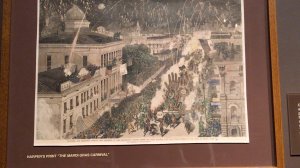MEMPHIS, Tenn. — When the world thinks of Mardi Gras they often think of New Orleans or Mobile.
But at one time Memphis was also one of the main places to be during the holiday.
On this Fat Tuesday, here are five interesting facts about Memphis Mardi Gras.
1) We Had One
In the 1870s, Memphis was looking to regain its economic vitality and prosperity after the Civil War and Reconstruction.
Tammy Braithwaite, the registrar for the Memphis Museum System and Pink Palace Museum, says Mardi Gras was brought to Memphis to recover that prosperity.
“For this area, it was a pretty big deal. Memphis had a population of about 40,000 people at that time. They estimated the crowd at the first Mardi Gras at 20,000 plus,” Braithwaite said.

Memphians began to make the festival more elaborate, and it was so well received that it drew greater attention locally and in the North.
“Each year that it occurred it started to get more and more attention for the city, it increased civic pride,” Braithwaite said.
Braithwaite says that Mardi Gras continued strong for about 20 years. It finally died down in the 1890s.
2) It Brought Business Back
Braithwaite says that Mardi Gras even drew the attention of Northern businesses to invest in the area again.
That had stopped during the Civil War, Braithwaite said.
The spring celebration brought in a lot of work for local businessmen and artists.
“It celebrated Memphis as a city. It celebrated its people. It used local people to produce really nice pieces of artwork,” Braithwaite said.
3) Secret Societies Made It Happen
The first event was so successful a secret society was formed to keep up interest — the Mystic Society of the Memphis.
They incorporated invitation-only balls and other events throughout the city.
Other secret societies formed in the 1870s.
4) Getting An Invitation Was a Really Big Deal
A Memphis artist, Carl Gutherz, was commissioned to create elaborate invitations to the societies’ parties and balls.
These invitations were sent out weeks in advance of the events, creating interest and envy. Many of the citizens didn’t know if they were going to get an invitation. Bribes were even offered to get an invite.
Braithwaite says Gutherz used mythical characters and fantasy figures to inspire costumes — figures like the Mad Hatter from Alice in Wonderland
He even designed the parade floats.
5) The Legacy Continues
The theory on why Memphis stopped it’s Mardi Gras tradition is uncertain.
Braithwaite says it could have been that they had just been doing it for so long that it died down.
Mardi Gras was reincarnated in 1931 as Cotton Carnival. Memphis was in the depression then and Memphis businessmen wanted a way to put a Memphis back on the map.
Braithwaite says the businessmen saw Mardi Gras as a great example what could happen and decided to do the same thing with the Cotton Carnival, now Carnival Memphis.





























